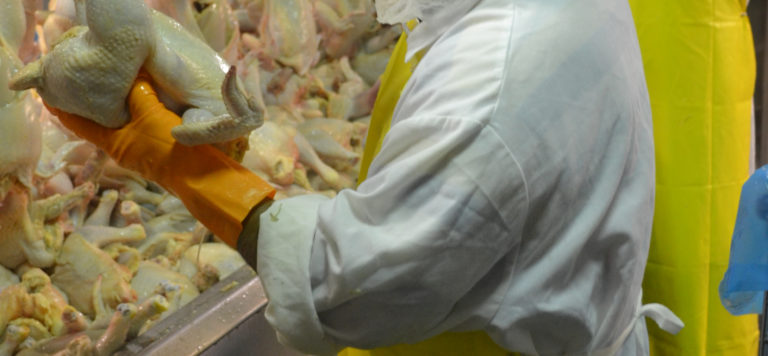
The National Employment Law Project (NELP) released yet another report finding poultry to be one of the most dangerous industries to work in, underscoring the continued importance of the UFCW’s efforts to provide a voice for the hard-working men and women of the poultry industry and to make sure no worker is left to suffer on their own.
The report takes a look at serious injury rates in 29 states and finds the rate of serious injuries, such as amputations, to be disproportionately high in poultry plants.
“OSHA’s severe injury data shines a light on the severe toll of preventable workplace injuries, especially in the U.S. poultry industry,” said Debbie Berkowitz, senior fellow for worker safety and health with NELP and the report’s lead author. “The workers who put food on our tables should not have to sacrifice their health for a paycheck.”
This report is consistent with similar trends shown in past reports by other organizations such as Oxfam, with whom the UFCW has worked to improve safety standards in the poultry and meatpacking industries.
Past reports have found workers at poultry plants, which have a much lower rate of union representation than other meat packing plants, were more likely to suffer from Cumulative Trauma Disorders (CTDs) and that many workers in nonunion plants were forced to use adult diapers due to a lack of bathroom breaks and the constant, grueling pace of work.
More injuries than saw mills and other high risk industries
Even when compared to other high risk industries, this report shows an alarmingly high injury rate:
According to the data, the poultry industry as a whole reported 180 severe injuries resulting in hospitalizations or amputations—a number that put them at the 12th-highest number of severe injuries reported to federal OSHA. Workers in the industry suffered a greater number of serious injuries than much of the construction industry, the auto industry, the steel industry, saw mills, and many other high-risk industries. And these numbers only reflect instances in 29 states. Further, OSHA followed up with inspections in response to 86 of these reports, finding a total of 750 violations in the plants, of which 84 were willful or repeat violations that carry the highest fines.
The rates of injury are likely even higher than reported
The report also makes note that as dramatic as the number of injuries are, they likely don’t come close to representing the full scope of the problem:
Three government agencies, OSHA, the National Institute for Occupational Safety and Health, and the GAO, have found that the poultry processing industry is underreporting the serious injuries that occur in the plants.
A 2009 Government Accountability Office (GAO) report, along with numerous other studies, have documented that many workplace injuries are not reported by employers. Further, according to a recent report issued by OSHA in 2016, “OSHA believes that many severe injuries—perhaps 50 percent or more—are not reported.”8 Other studies have concluded that the actual number of work-related injuries is three times higher than what companies report.
In 2016, the UFCW was a vocal supporter of OSHA’s decision to issue a citation to Pilgrim’s Pride, only the second citation of its kind in the agency’s 47-year history. “We are disappointed to see yet another example of poultry workers being mistreated and forced to endure harsh working conditions,” said UFCW International President Marc Perrone. “As we strive to improve poultry industry jobs, we applaud OSHA for actively supporting the right of every worker to have a safe workplace.”
The citation alleged that “the employer delayed evaluation, care, and/or treatment from a medical provider, which could result in health hazards such as, but not limited to, increased risk of further injury, prolonged healing, exacerbation of pain and limited recovery from work-related injuries/illnesses.” The citation went on to describe that Pilgrim’s Pride “failed to make timely appropriate medical referrals for employees with injuries related to chronic and acute exposures and incidents. The employees are exposed to injuries which include burns, loss of consciousness, and blunt force trauma which require appropriate evaluation and treatment.”
UFCW’s presence is vital
UFCW contracts include health and safety language to protect workers. This helps to ensure safe working conditions, union access to perform worksite inspections and medical and exposure records, training, joint health and safety committees, protective equipment and chief, walking and ergonomic stewards that can accompany government inspectors during their paid time. Union contracts also include reimbursement for protective gear.
But the percentage of workers who have UFCW representation is much lower in poultry plants than in other meat packing plants. Only about a third of poultry workers are UFCW members, making improvements in workplace safety more difficult to secure.
Beyond additional workplace protections offered by a union contract, the UFCW’s influence in these plants helps combat a climate of fear and intimidation.
“Many workers are afraid to speak up and advocate for better treatment. Companies increasingly turn to ‘a variety of economically desperate and socially isolated populations,’ many of whom face obstacles that prevent them from standing up and speaking out about abuses in the workplace. In the words of many, the industry takes advantage of workers who live and work in a climate of fear. – Lives on the Line: The Cost of Cheap Chicken, Oxfam
Both in the recommendations of the most recent NELP report and in past reports such as Oxfam’s Lives on the Line: The Cost of Cheap Chicken, the need for workers to have better compensation and a voice on the job is repeatedly echoed.
“Unions provide poultry workers with one of the best ways to improve their safety on the job because we create an environment where people know their rights and feel empowered to speak up,” said Perrone. “We make sure that workers can advocate for their well-being without the fear of being fired.”
Progress through partnership
The NELP report comes on the heels of Tyson’s announcement to rededicate itself to workplace safety. The day before the report was released, Tyson committed to continuing its collaboration with the UFCW on a workplace safety and illness and injury prevention initiative that will be rolled out to all plants and be released publicly. Other highlights in the company’s announcement include:
- A new initiative on transparency stating that the company will begin publicly sharing results of its third party social compliance audits.
- A new initiative on compensation stating that Tyson Foods will make sure it’s providing competitive wages and benefits.
- Reaffirming its commitment to allowing regularly scheduled breaks, as well as restroom breaks, as needed.
- Reaffirming its commitment to running its processes at a speed according to the number of people available to work.
- Reaffirming its commitment to a policy allowing workers to stop the line at any time for worker or food safety issues.
- Reaffirming its commitment to having Team Member safety councils in place at all plants.
“Tyson Foods’ commitment to worker safety and workers’ rights should not just be applauded — it should serve as a model for the rest of the industry,” said Perrone. “Through our ongoing partnership with Tyson Foods, we have already made valuable progress. We look forward to these new and expanded initiatives and to continuing to work together to provide a better, safer workplace for the hard-working men and women at Tyson Foods.”

